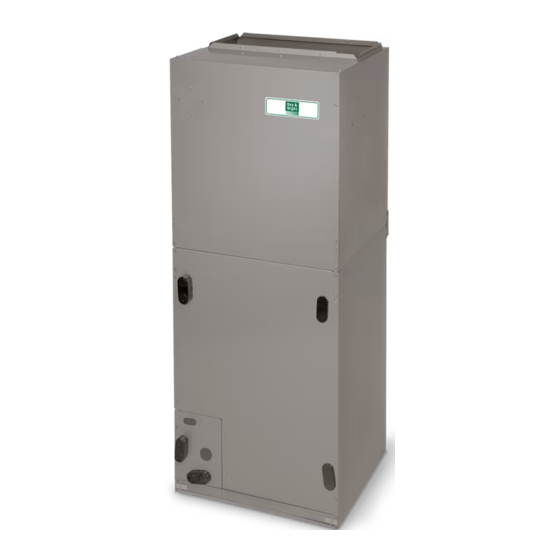- ページ 5
ヒートポンプ Day and Night HCH6のPDF 取付説明書をオンラインで閲覧またはダウンロードできます。Day and Night HCH6 16 ページ。 R?410a two?stage split system heat pumps

INSTALLATION INSTRUCTIONS
Outdoor Unit Connected to Factory Approved
Indoor Unit
These outdoor units are carefully evaluated and listed with
specific indoor coils for proper system performance.
Install Adapter Tube
1. Remove plastic retainer holding outdoor piston in liquid
service valve.
2. Check outdoor piston size with matching number listed
on unit rating plate.
3. Locate plastic bag taped to unit containing adapter
tube.
4. Remove Teflon® seal from bag and install on open
end of liquid service valve. (See Fig. 3.)
5. Remove adapter tube from bag and connect threaded
nut to liquid service valve. Tighten nut finger−tight and
then with wrench an additional 1/2 turn (15 ft−lb). DO
NOT OVER TIGHTEN!
Figure 3
Install Liquid Line Filter Drier Indoor
Refer to Fig. 4 and install filter drier as follows:
1. Braze 5 in. (127 mm) liquid tube to the indoor coil.
2. Wrap filter drier with damp cloth.
3. Braze filter drier to 5 in. (127 mm) liquid tube from
step 1.
4. Connect and braze liquid refrigerant tube to the filter
drier.
Figure 4
Refrigerant Tubing and Sweat Connections
Use refrigerant grade tubing. Service valves are closed from
factory and ready for brazing. After wrapping service valves
with a wet cloth, braze sweat connections using industry
accepted methods and materials. Consult local code
requirements. Refrigerant tubing and indoor coil are now
ready for leak testing . This check should include all field and
factory joints.
428 01 1703 01
Liquid Service Valve
Liquid Line Filter Drier
Specifications subject to change without notice.
CAUTION
!
UNIT DAMAGE HAZARD
Failure to follow this caution may result in equipment
damage or improper operation.
Service valves must be wrapped in a heat−sinking
material such as a wet cloth while brazing.
CAUTION
!
UNIT DAMAGE HAZARD
Failure to follow this caution may result in equipment
damage or improper operation.
Installation of filter drier in liquid line is required.
Evacuate Refrigerant Tubing and Indoor Coil
CAUTION
!
UNIT DAMAGE HAZARD
Failure to follow this caution may result in equipment
damage or improper operation.
Never use the system compressor as a vacuum pump.
Refrigerant tubes and indoor coil should be evacuated using
the recommended deep vacuum method of 500 microns. An
alternate triple evacuation method may be used.
IMPORTANT: Always break a vacuum with dry nitrogen.
Deep Vacuum Method
The deep vacuum method requires a vacuum pump capable
of pulling a vacuum of 500 microns and a vacuum gage
capable of accurately measuring this vacuum depth. The
deep vacuum method is the most positive way of assuring a
system is free of air and liquid water. (See Fig.5)
Figure 5
5000
4500
4000
3500
3000
2500
2000
1500
1000
500
0
1
2
3
MINUTES
Triple Evacuation Method
The triple evacuation method should only be used when
system does not contain any water in liquid form and vacuum
pump is only capable of pulling down to 28 inches of mercury
(711mm Hg). Refer to Fig. 6 and proceed is as follows:
1. Pull system down to 28 inches of mercury (711mm Hg)
and allow pump to continue operating for an additional
15 minutes.
2. Close manifold valves or valve at vacuum pump and
shut off vacuum pump.
3. Connect a nitrogen cylinder and regulator to system
and fill with nitrogen until system pressure is 2 psig.
R−410A Split System Heat Pumps
Deep Vacuum Graph
LEAK IN
SYSTEM
VACUUM TIGHT
TOO WET
TIGHT
DRY SYSTEM
4
5
6
7
A95424
5
